The circle of fifths and how it relates to piano playing
Some of my previous blogs were based on technical issues like how to play the c major scale or how to look at a chord in order to make the piano easier to play.
This post is about making the piano easier to understand. In my piano lessons, my students very often ask me about the circle of fifths and their use in piano playing. Essentially, it is the easiest way to memorize all the scales and how many sharps or flats they each have. Since most pieces are based on scales and a have certain tonal center, it is extremely important to feel confident about playing the scales and picturing the sharps and flats corresponding to each scale.
The piano is a very visual instrument. You see a key, you press a key and sound is there. The seven steps of the scale are easy to be found if you get used to the shape of the black keys. Around the groups of three black keys are the tones f, g, a, b (from lower to higher).

Around the two black key groups are the tones c, d, e (again from lower to higher).

Every scale has 7 steps. They are either half steps, two adjacent keys including the black keys such as b to c, or whole steps, equal to two half steps such as f to g. The major scale always follows the following pattern.
W = Whole Step
H = Half Step
Major scales ascend with the pattern: W – W- H – W – W – W – H
For Example C Major: C – D – E – F – G – A – B – C
Natural minor scales ascend with the pattern: W – H – W – W – H – W – W
For Example A natural minor: A – B – C – D – E – F – G – A
Now try to think through any scale by calculating the pattern of whole and half steps. Try D♭ Major for starters.
Scroll down to the bottom of the page for the solution!
It wasn’t so easy was it? The circle of fifths gives you an easier way! The easiest way to memorize and understand the scales and their accidentals are by memorizing the circle of fifths. If you go clockwise, the beginning note of each scale is perfect fifth apart. For example, if C is the first note count C as 1, D as 2, E as 3, F as 4 and G as 5. Therefore the interval (or distance) between C and G is a fifth.
As you can see from the picture below the circle of fifths looks like a clock and just like a real clock the accidentals for sharpened keys progress clockwise and the accidentals for flattened keys progress counterclockwise. The circle of fifths produces all major scales with sharps and all major scales with flats.


There is also an order of sharps. If there is one sharp it is always F#. Two sharps is always F# and C#. See the following chart to give you the order of sharps and flats.

To determine which notes are used in the scale follow this procedure:
- Determine the number of sharps or flats in the key by looking at the chart above or the circle of fifths.
- Using the chart below, find that number in the first row. The note below it and all previous notes (to the left) will be sharp or flat in that key.
For example, if you want the notes for the F# Major scale you do the following. According to the circle of fifths, F# has 6 sharps. According to the order of sharps, those sharps must be F♯, C♯, G♯, D♯, A♯, E♯. The scale will also have the same sharps, therefore the F♯ major scale in order is F♯ – G♯ – A♯ – B – C♯ – D♯ – E♯ – F♯.
The good news is that, when playing scales on the piano, the fingering is going to be always the same, unless the scale starts from a black key. The right hand will be 1 – 2 – 3 – 1 – 2 – 3 – 4 – 5, and the left hand will be 5 – 4 – 3 – 2 – 1 – 3 – 2 – 1. This fingering is the same as the C scale fingering.
Once you master the fingering of the c major scale, all the other scales have exactly the same fingering for both hands. The only thing changing is the number of sharpened or flattened keys you will have.
The Circle of fifths and its use in piano playing is a topic which I get to discuss very often in lessons with my students. I use this knowledge in my practice every day, as do my students. I am sure that you will find it useful, too. Here is a link of a very interesting site I happened to find online. Piano clues discuss interesting topics from the practical and technical piano world.
The solution:
D♭ Major: D♭ – E♭ – F – G♭ – A♭ – B♭ – C – D♭
Related



Staff
